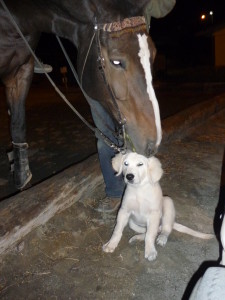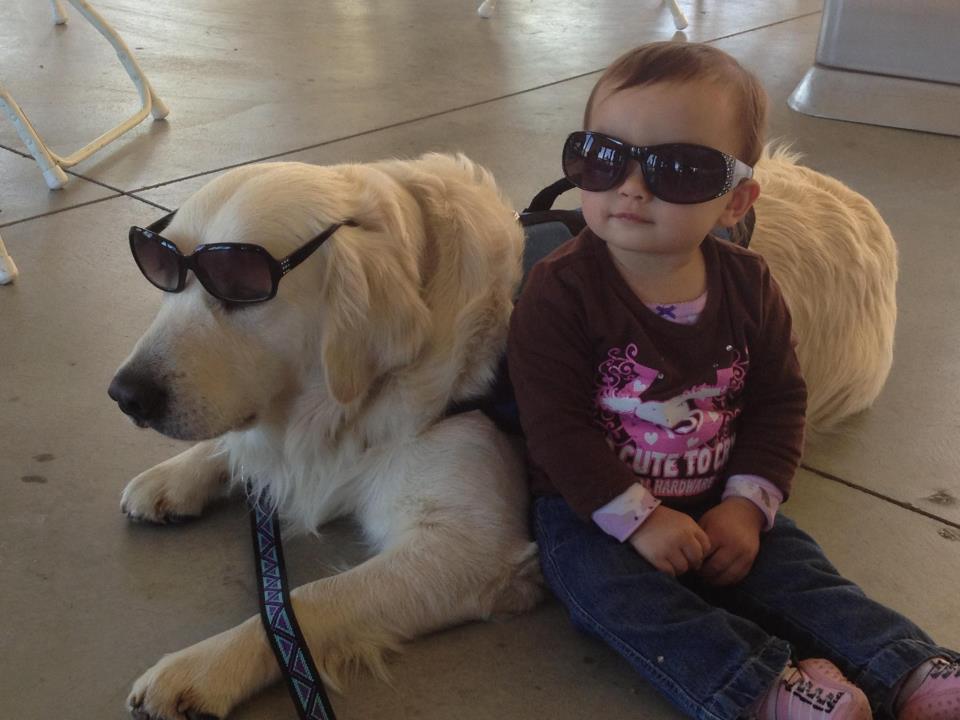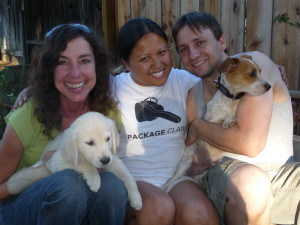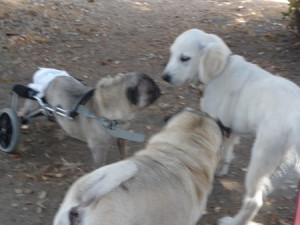 So What now?
So What now?
You have this adorable new addition to your family and he is running a hundred miles an hour around your house, with your favorite shoe in his mouth, piddling as he goes  Don’t worry we are here for you. Your pup deserves your undivided attention the minute he get’s home. He watches your every move. You are his coach, his mentor and he will mimic and adore you. Please use this amazing opportunity to constantly be teaching him. Just like a baby they will learn new words. Start with his name and the other very important words, No, Leave it, Drop it, Get it (they are retrievers..this is a very important one) Come, Stay, Sit and Lay down.
Don’t worry we are here for you. Your pup deserves your undivided attention the minute he get’s home. He watches your every move. You are his coach, his mentor and he will mimic and adore you. Please use this amazing opportunity to constantly be teaching him. Just like a baby they will learn new words. Start with his name and the other very important words, No, Leave it, Drop it, Get it (they are retrievers..this is a very important one) Come, Stay, Sit and Lay down.
Since your fur baby will not be able to go immediately to training in most cases this video training series is especially valuable. We have developed a step by step program that you can view for 14 days free and after that it is just $97. A fraction of the cost of a personal trainer.
Young puppies can have a big head start on their puppy training schedule. The Canine Coach is 100% at home and can be used on a frisky 8 week old puppy who hasn’t had its 16 week vaccinations yet!! Not only safely train at home during this time period but take advantage of this time period where your puppy is learning 4x faster than his older superiors!
AND A MONEY BACK GUARANTEE. FIND AN ONLINE TRAINING PROGRAM COMPARABLE
TO THE CANINE COACH IN QUALITY AND DURATION AT A PRICE LOWER THAN $97 AND GET YOUR COURSE FOR FREE!!!
If you are local to Southern California we have an amazing personal trainer that is very familiar with the high level of intelligence Shilo puppies have and will work with you to make the most of your relationship. His name is Hogan Rangel, Please contact him directly at 951-840-7835. He has a Shilo puppy, Bodhi that was just awarded National and International Puppy Champion titles from The IABCA. He and I use AKC guidelines but also deviate to compensate for their particular dispositions. See AKC Star Puppy Program
Here’s a link of the first time Bodhi (Shilos son in the guardian program) saw Shilo.
Click Here
_______________________________________
A WORD OR TWO ON SOCIALIZING YOUR PUPPY FROM THE ASPCA
Socialization means learning to be part of society. When we talk about socializing pet puppies, it means helping them learn to be comfortable as a pet within human society—a society that includes many different types of people, environments, buildings, sights, noises, smells, animals and other dogs.
Most young animals, including dogs, are naturally made to be able to get used to the everyday things they encounter in their environment—until they reach a certain age. When they reach that age, they are naturally made to become much more suspicious of things they haven’t yet experienced. Mother Nature is smart! This age-specific natural development lets a young puppy get comfortable with the everyday sights, sounds, people and animals that will be a part of his life. It ensures that he doesn’t spend his life jumping in fright at every blowing leaf or bird song. The later suspicion they develop in later puppy hood also ensures that he does react with a healthy dose of caution to new things that could truly be dangerous.
What Age Is Best for Puppy Socialization?
Puppies are most accepting of new experiences between 3 and 12 weeks old. After that age, they become much more cautious of anything they haven’t yet encountered. From about 12 to 18 weeks old the opportunity to easily socialize the puppy ends—and with each passing week it becomes harder to get the pup to accept and enjoy something that he’s initially wary of. After 18 weeks old, it’s extremely difficult, and sometimes impossible, to teach a dog to like something new, or help him become comfortable with something he finds frightening.
Why Is Puppy Socialization Important?
 Well-socialized puppies usually develop into safer, more relaxed and enjoyable pet dogs. This is because they’re more comfortable in a wider variety of situations than poorly socialized dogs, so they’re less likely to behave fearfully or aggressively when faced with something new. Poorly socialized dogs are much more likely to react with fear or aggression to unfamiliar people, dogs and experiences. Dogs who are relaxed about honking horns, cats, cyclists, veterinary examinations, crowds and long stairwells are easier and safer to live with than dogs who find these situations threatening. Well-socialized dogs also live much more relaxed, peaceful and happy lives than dogs who are constantly stressed out by their environment.
Well-socialized puppies usually develop into safer, more relaxed and enjoyable pet dogs. This is because they’re more comfortable in a wider variety of situations than poorly socialized dogs, so they’re less likely to behave fearfully or aggressively when faced with something new. Poorly socialized dogs are much more likely to react with fear or aggression to unfamiliar people, dogs and experiences. Dogs who are relaxed about honking horns, cats, cyclists, veterinary examinations, crowds and long stairwells are easier and safer to live with than dogs who find these situations threatening. Well-socialized dogs also live much more relaxed, peaceful and happy lives than dogs who are constantly stressed out by their environment.
Socialization isn’t an “all or nothing” project. You can socialize a puppy a bit, a lot, or a whole lot. The wider the range of experiences you expose him to, the better his chances are of being comfortable in a wide variety of situations as an adult.
How Does a Puppy Need to Be Socialized?
Socialization is a big project. It requires exposure to the types of people, animals, places, sounds and experiences that you expect your dog to be comfortable in later in life. Depending on the lifestyle you have planned for your dog, this might include the sight and sound of trains, garbage trucks, schoolyards of screaming children, crowds, cats, livestock or crying infants. While it’s impossible to expose a young puppy to absolutely everything he will ever encounter in life, the more bases that you cover during the peak socialization period of 3 to 12 weeks, the more likely the puppy will be able to generalize from his prior experiences and find something reassuringly familiar in a new situation. For any pet dog, it’s essential to get him used to the common types of people, dogs, sights, sounds and physical handling and grooming that will be a sure part of his daily life.
Do I Need to Do Anything Special When I Socialize My Puppy?
Yes! You need to make sure that the situation is not overwhelming for him, and that he becomes more comfortable—not more worried—each time you expose him to something. For instance, maybe you’ve planned a puppy party where a group of people will gather to help you socialize your puppy right at home. But some puppies can be overwhelmed by meeting a bunch of strangers all at once. Even though your intentions are good, if your puppy is cowering in the corner at his own party, then he’s not learning anything good about strangers! The rule of thumb with puppy socialization is to keep a close eye on your puppy’s reaction to whatever you expose him to so that you can tone things down if your pup seems at all frightened. Always follow up a socialization experience with praise, petting, a fun game or a special treat.
What If My Puppy Seems Frightened During Socialization?
Even though 3 to 12 weeks old is a time when puppies are most comfortable with new experiences, they might sometimes find a new experience frightening. Whenever this happens, it’s important to introduce your puppy to the scary situation much more gradually, and to make a big effort to do something your puppy loves during the situation or right afterwards. For example, if your puppy seems to be frightened while sitting on your lap in a schoolyard full of children, then sit further away from the action and offer your pup a delicious treat each time a scary noise or movement happens. Another solution is to go to a much quieter park where only a few children are playing, use praise and treats to help convince him it’s a great place to be, and then over days or even weeks of your socialization sessions, gradually approach a schoolyard again once he’s started to like the sights and sounds of active children. (For more detailed information, please read our article, Fear of Children.)
Puppy Classes
One great way to help socialize a puppy is to attend puppy kindergarten classes. These are classes designed especially for puppy training and early socialization. In a typical puppy class, off-leash play and play-fighting helps socialize puppies with each other, teaches them to be gentle with their mouthing and biting, and gets them used to being handled by a variety of people. Some classes even include exposure to odd sights and sounds using props, CDs of sounds, and theatrics with costumes to accustom the puppies to a wide range of life experiences. Puppy classes also teach some basic obedience skills, so on top of the socialization component, you’ll learn how to ask your pup to comply with your requests and behave according to your expectations.
Vaccinations and Disease Risk During Early Socialization
Most young puppies aren’t fully protected against the diseases we vaccinated them for until they’ve had all of their puppy shots. This is mainly because the antibodies they get from their mother can interfere with the ability of the vaccine to have its full effect. Even though puppies’ immune systems are still developing during their early months, if we wait until a puppy has all of his shots before socializing him, we miss our chance to do it. He’ll simply be too old. The good news is that if you take some commonsense precautions while socializing your puppy, the risk of infection is quite small compared to the much larger risk of your puppy developing serious behavior problems with fear and aggression later in life.
Veterinarians specializing in behavior recommend that owners take advantage of every opportunity to socialize young puppies in environments like puppy classes, where the risk of illness can be minimized. They state that:
“Puppy socialization classes offer a safe and organized means of socializing puppies. Each puppy should have up-to-date vaccinations and be disease and parasite free before entering the class. Where possible, classes should be held on surfaces that are easily cleaned and disinfected (e.g., indoor environments). Visits to dog parks or other areas that aren’t sanitized or are highly trafficked by dogs of unknown vaccination or disease status should be avoided.”
The experts now agree that the risk of a puppy being given up or later euthanized for behavior problems is so huge that young puppies must be socialized before they are done with their vaccinations. The recommendation is to socialize puppies as safely as possible by exposing the puppy to people, places and other animals while not taking unnecessary risks. Well-run puppy classes—indoor classes where all the puppies have been vaccinated at least once—are a safe and smart way to socialize a puppy.
“In general, puppies can start puppy socialization classes as early as 7 to 8 weeks of age. Puppies should receive a minimum of one set of vaccines at least 7 days prior to the first class and a first deworming. They should be kept up-to-date on vaccines throughout the class.”
“The American Veterinary Society of Animal Behavior believes that it should be the standard of care for puppies to receive such socialization before they are fully vaccinated.”
Other Safe Ways to Safely Socialize a Puppy Who Is Not Fully Vaccinated
- Drive to a busy mall and hang out with your pup on a mat at the entrance. Strangers will flock to you because they want to pet your puppy and they’ll willingly feed him the treats that you’ve brought with you.
- Host a puppy party! Invite friends and family over, play some music, toss some streamers, and pass your pup around.
- Bring your puppy to indoor Scouts meetings. Supervise the children interacting with him to make sure he’s not frightened by them and they’re being gentle.
- Take your pup on car rides through different neighborhoods, drive-thrus, car washes, and out into the country where he’ll see and smell a variety of farm animals.
- Arrange play sessions with other puppies and adult dogs who you know are healthy and friendly.
- If your puppy is small enough, carry him around town and let strangers pet him and give him treats.
Exposure Checklist for Socialization
Use this checklist to help keep track of what your puppy has been exposed to. Place a check mark in the box corresponding to the item your puppy was exposed to and at what age.
| Age in weeks: | 8 | 9 | 10 | 11 | 12 | 13 | 14 | 15 | 16 |
| Exposure to: | |||||||||
| Babies, toddlers, children | |||||||||
| Teenagers, adults, elderly people | |||||||||
| People with wheelchairs, crutches | |||||||||
| In-line skaters, cyclists, skateboarders | |||||||||
| Drunk people, people with odd gaits | |||||||||
| People in uniform, veterinarians | |||||||||
| Repair people, delivery people | |||||||||
| People with umbrellas, helmets, masks | |||||||||
| People with hats, beards, glasses | |||||||||
| People with parcels, capes, sacks | |||||||||
| People with strollers, wagons | |||||||||
| People of various ethnicities | |||||||||
| Kids at school grounds | |||||||||
| Crowds, clapping, cheering | |||||||||
| People yelling, loud speakers | |||||||||
| People dancing, singing | |||||||||
| Livestock, waterfowl | |||||||||
| Other puppies, friendly adult dogs | |||||||||
| Other pets | |||||||||
| Traffic, busses, trains, motorcycles | |||||||||
| Boats, jet skis, snow mobiles | |||||||||
| Manhole covers, grates | |||||||||
| Shiny floors, tiles, icy streets | |||||||||
| Gravel, cement, mud | |||||||||
| Revolving signs, swinging bridges | |||||||||
| Walks after dark, in bad weather | |||||||||
| Hot air balloons & airplanes | |||||||||
| Lawn mowers | |||||||||
| Elevators, automatic doors | |||||||||
| Balconies, stairs | |||||||||
| Drive-thru’s, car washes, tunnels | |||||||||
| Electrical appliances, washers | |||||||||
| Vacuum cleaners, hair dryers | |||||||||
| Construction and machinery noises | |||||||||
| Wind, rain, thunder, snow | |||||||||
| Fireworks, sporting events, fairs | |||||||||
| Veterinary hospitals and clinics |
Final Remarks
Socialization is essential for helping your puppy develop into a happy, fun and safe companion. Most people find it easier and more enjoyable to live with a dog who’s relaxed with strangers, gets along well with dogs and adapts easily to new experiences. While some dogs are born with genetic predispositions that can make this difficult or impossible, most dogs are very impressionable when young and can learn to take everything in stride. Socializing your puppy gives him the greatest chance possible to develop into a dog who’s comfortable in his environment and a joy to be with.


